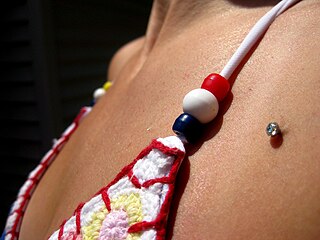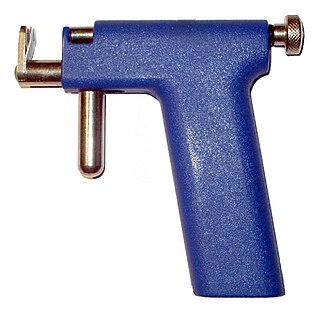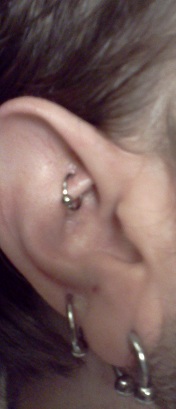Related Research Articles

The Prince Albert (PA) is a penis piercing which extends from the urethra to the underside of the glans. It is one of the most common male genital piercings. The related reverse Prince Albert piercing enters through the urethra and exits through a hole pierced in the top of the glans.

An earring is a piece of jewelry attached to the ear via a piercing in the earlobe or another external part of the ear, or, less often, by some other means. Earrings have been worn by people in different civilizations and historic periods, often with cultural significance.

An eyebrow piercing is a vertical surface piercing, wherein a twelve to eighteen gauge cannula needle is inserted through the bottom of the eyebrow and exits through the top of the eyebrow to permit insertion of jewellery. Those performing the piercing may use a pennington clamp to better guide the needle through the skin. A curved barbell is the most common jewellery inserted post-piercing.

A tongue piercing is a body piercing usually done directly through the center of the tongue. Since its decline in popularity around 2011, it has seen a recent upsurge making it now the second most popular piercing amongst young women aged 18-25 in 2019. It has become quite unpopular amongst men, although in the 1990s and early 2000s, it was more popular for men than women to get and associated with punk culture. Midline tongue piercings, or one hole through the center of the tongue is the most common way to have the tongue pierced.
In surgery, a percutaneous procedure is any medical procedure or method where access to inner organs or other tissue is done via needle-puncture of the skin, rather than by using an "open" approach where inner organs or tissue are exposed.

A frenum piercing is a type of body piercing located on the underside of the shaft of the penis. A series of parallel frenum piercings is known as a frenum ladder. A frenum ladder may be extended to include lorum piercings, hafada piercings and guiche piercings.

Transdermal implants, or dermal piercings, are a form of body modification used both in a medical and aesthetic context. In either case, they consist of an object placed partially below and partially above the skin, thus transdermal. The skin around it generally heals as if it were a piercing.
In modern Western body piercing, a wide variety of materials are used. Some cannot be autoclaved, and others may induce allergic reactions, or harbour bacteria. Certain countries, such as those belonging to the EU, have legal regulations specifying which materials can be used in new piercings.
A transscrotal piercing is a body piercing that travels through the scrotum from front to back, or from side to side. It is a high risk procedure.

An ear-piercing instrument is a device designed to pierce earlobes by driving a pointed starter stud through the lobe. Piercing guns are typically used for ear piercing in mall jewelry shops, beauty salons, pharmacies, and doctors' offices.
Stretching, in the context of body piercing, is the deliberate expansion of a healed piercing for the purpose of wearing certain types of jewelry. Ear piercings are the most commonly stretched piercings, with nasal septum piercings, tongue piercings and lip piercings/lip plates following close behind. While all piercings can be stretched to some degree, cartilage piercings are usually more difficult to stretch and more likely to form hypertrophic scars if stretched quickly. Dermal punching is generally the preferred method for accommodating larger jewelry in cartilage piercings.

A rook piercing is a perforation of the antihelix of the ear for the purpose of wearing jewelry. It is located just above the tragus on the ridge between the inner and outer conch with the piercing passing from the underside to the top of this ridge, differing from many ear piercings that essentially span between a "front" and "back" surface. Erik Dakota, a well known professional piercer and the individual responsible for originating and popularizing the rook piercing, is said to have named this modification after a shortened version of his first name. The piercing was first named in issue #4 of the magazine Body Play and Modern Primitives Quarterly around 1992 alongside the first printed reference to the industrial piercing, then termed "industrial ear project".

Piercing migration is the process that occurs when a body piercing moves from its initial location. This process can be painful or go unnoticed, until it has progressed. Given enough time, a ring may migrate entirely outside of the skin, although it may only migrate a small amount and come to rest.

Labia piercings are a type of female genital piercing. This piercing can be placed either through the labia minora or the labia majora. They are one of the simpler and more common genital piercings performed on vulvas, and are often pierced in symmetrical pairs. Like all genital piercings, depending on jewellery and placement, they may provide additional stimulation to one or both partners during sexual intercourse.

In body modification, an implant is a device that is placed under the human skin for decorative purposes. Such implants may be subdermal or transdermal. In the context of body modification, some may consider injections of silicone and other substances a type of implant as well.

A taper insertion pin, also known as a taper, is a tool used for enlarging holes for body modification purposes.

A plug, in the context of body modification, is a short, cylindrical piece of jewelry commonly worn in larger-gauge body piercings. Modern western plugs are also called flesh tunnels. Because of their size—which is often substantially thicker than a standard metal earring—plugs can be made out of almost any material. Acrylic glass, metal, wood, bone, stone, horn, glass, silicone or porcelain are all potential plug materials.

Body piercing, which is a form of body modification, is the practice of puncturing or cutting a part of the human body, creating an opening in which jewelry may be worn, or where an implant could be inserted. The word piercing can refer to the act or practice of body piercing, or to an opening in the body created by this act or practice. It can also, by metonymy, refer to the resulting decoration, or to the decorative jewelry used. Piercing implants alter the body and/or skin profile and appearance. Although the history of body piercing is obscured by popular misinformation and by a lack of scholarly reference, ample evidence exists to document that it has been practiced in various forms by multiple sexes since ancient times throughout the world. Body piercing can be performed on people of all ages, although most minors are only permitted to have earlobe piercings.
Ear piercing is one of the oldest forms of body modification. It occurs when holes are created on the ear lobes or cartilage to allow the insertion of decorative ornaments, such as earrings. Ear piercing in children has been around for centuries as part of ritualistic and cultural traditions but has continued to become a worldwide mainstream fashion statement. It is extremely common in Nigeria, India, Brazil and Hispanic countries.
References
- ↑ Hesse, Rayner W. (2007). Jewelrymaking through history: an encyclopedia. Greenwood Publishing Group. p. 27. ISBN 978-0-313-33507-5.
- ↑ "Ear Scalpelling". Holier Than Thou. Archived from the original on 10 December 2010. Retrieved 5 July 2011.
- 1 2 DeMello, Margo (2007). Encyclopedia of Body Adornment. ABC-CLIO. p. 234. ISBN 978-0-313-33695-9.
- ↑ T., Tania. "Scalpelling". Steady Health. Retrieved 5 July 2011.
- ↑ Philips, Sean. "Scalpelling". BMEZINE. Retrieved 5 July 2011.